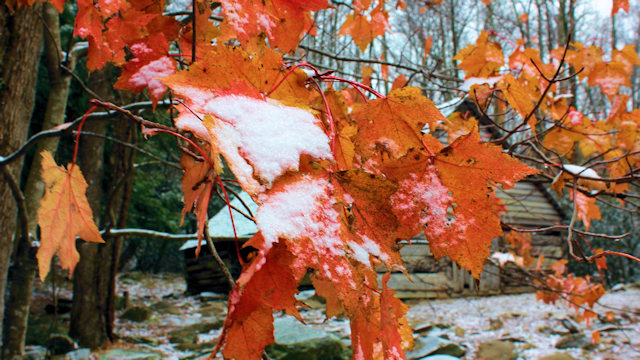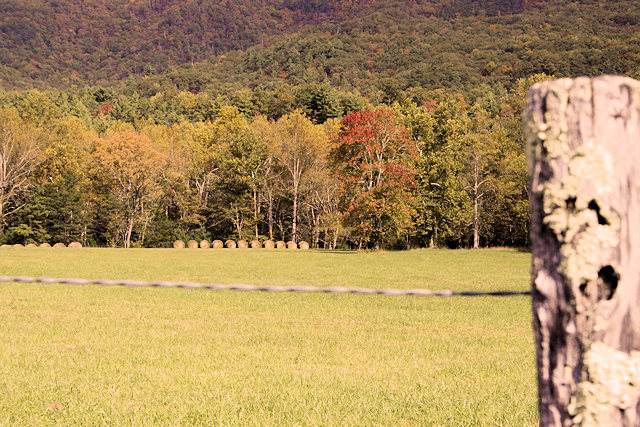A Guide to Fall Foliage in the Smokies

An early snowfall on some leaves in the Smokies. Photo by Shane Dunnaway.
Fall in the Smokies mean two things – cooler temperatures, of course, but also the opportunity for visitors to the Smoky Mountains to view some of the most spectacular displays of fall foliage the world has to offer.
Changing climates at different elevations in the Great Smoky Mountains National Park have a profound effect on when fall color changes appear. In higher, cooler elevations in the park, leaves begin to change color as early as mid-September on trees such as the yellow birch, the American beech, the mountain maple, the hobblebush, and the pin cherry.
Color changes in leaves typically begin as the summer ends, when the green pigments in leaves deteriorate, bringing out the leaves’ other hidden colors. Carotenoids, the same pigment that makes carrots orange and leaves yellow, are exposed as the green fades. Reds and purples come from anthocyanins, a pigment that is formed when sugars in leaves break down in bright autumn sunlight.
From early to mid-October, fall colors reach their peak at approximately 4,000 feet. To reach an area of high elevation to catch these early fall transitions, you can drive the Clingmans Dome Road, which ends only 0.5 miles from the 6,643-foot Clingmans Dome summit and offers numerous scenic pullouts to provide amazing views of the area’s ridges and valleys; the Blue Ridge Parkway, which features elevations ranging from just under 650 feet to over 6,000 feet; and the Foothills Parkway, an unfinished highway that still provides scenic routes along the western side of Chilhowee Mountain in Blount County, the eastern side of Cove Mountain between Pigeon Forge and the Great Smoky Mountains National Park, and over Green Mountain in Cocke County, Tennessee.
Fall color displays usually reach their peak at mid and lower elevations between mid-October and early November. Trees such as the sugar maple, the scarlet oak, the sweetgum, the red maple, and the hickories present a dazzling display of colors during this period. The Great Smoky Mountains National Park boasts an amazing diversity of trees, featuring some 100 species, most of which are deciduous.
While virtually the entire Smoky Mountain region comes alive with the colors of fall, there are a few spots of particular interest you’ll want to be sure to check out if you come for an autumn visit.
Autumn Scenic Drives in the Smokies

A scene from Cades Cove in the early fall months.
Roaring Fork Motor Nature Trail
The Roaring Fork Motor Nature Trail is a narrow, steep, but paved one-way road which winds through beautiful forests and gives its travelers a great chance to observe the Roaring Fork creek. It is designed for leisurely travel and is impassible to motor homes, buses, or trailers. It is closed in the winter.
In addition to the natural beauty on display along Roaring Fork, a number of historic log and frame buildings can also be seen. Of these, the Reagan tub mill, a tiny grist mill once used for grinding corn into corn meal, is of particular interest. The restored mill is located very close to the road, so travelers along the trail can get a good look at it.
Near the end of the road, a waterfall known as the “Place of a Thousand Drips” is located on the left. Wet weather can make this waterfall a truly remarkable sight to behold, and it serves as a glorious ending to this picturesque nature trail.
Cades Cove Loop Road
For an excellent display of late fall colors, try out this paved, 11-mile, one-way loop road, which offers wildlife viewing and access to a historic grist mill, churches, and log homes. To take in the whole loop, you’ll need to give yourself at least two to three hours of driving time. The road is open from sunrise to sunset every day.
The only exception is on Wednesday and Saturday mornings, when the road does not open until 10 a.m. (Eastern Time). This is to allow pedestrians and bicyclists to use the road from sunrise until then. For more information on the Cades Cove Loop Road, visit our section on scenic drives in the Smokies.
Suggested Hikes
- Appalachian Trail
- Inspiration Point on Alum Cave Trail
- Oconaluftee River Trail
- Look Rock Tower
- Sutton Ridge Overlook
October is a busy month in the Great Smoky Mountains National Park, so it is advisable to make accommodation reservations as early as possible. While no motels or rental cabins are located within the park, communities in the surrounding area offer a wide choice of lodgings, including hotels, cabins, bed & breakfasts, and campgrounds.
If you’d like to get a peek at how falls colors are developing in the park, you can check out live webcams for Look Rock, located mid-elevation on the western end of the park, and Purchase Knob, located at high elevation on the eastern end of the park, on the Great Smoky Mountains National Park website.
